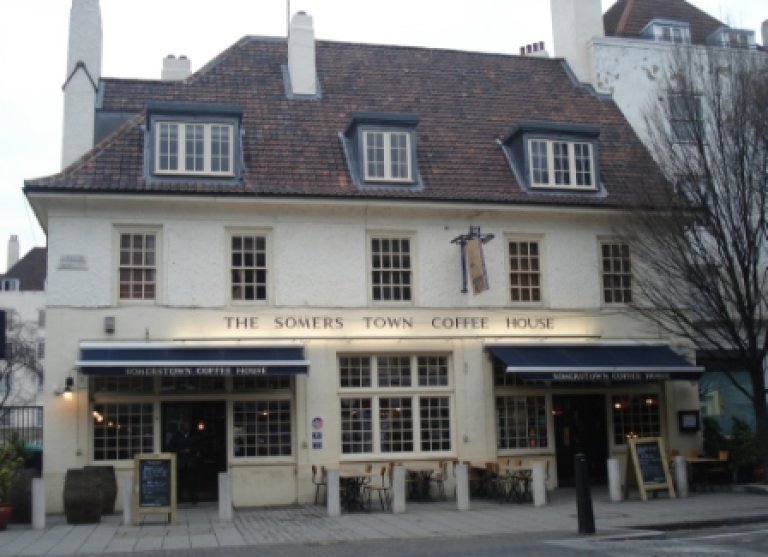Somers Town Coffee House
60 Chalton StreetSomers Town
NW1 1HS
This pub is not only a grade II listed building, it is also on the Campaign for Real Ale’s (CAMRA) Local Inventory with an interior of local historic interest, and the description is as follows: "Purpose built pub as part of the Ossulston Estate housing development between 1927 and 1931 that replaced an older pub (formerly a Coffee House) from the 19c. It is grade II listed as part of Levita House, the southern part of the Estate. It is two storeys of rough cast walls with an attic. There are two vestibule entrances at the front with wooden glazed screens which seem to a result of a 2011 refurbishment.
The interior is now one large room with a L-shaped bar counter off-set to the left and a room to the left rear separated by a folding door which is modern, replacing what seems to have originally been a sliding door. The 2011 refurbishment resulted in the modern bar back with small coloured tiles which is at odds with the 1930’s three quarter height wood panelling that runs throughout the interior. The bar counter is formed of large wooden panels divided by plain carved columns topped with decorative brackets.
There is a passage behind the bar leading to the toilets and stairs to the upstairs (private). At the back of the left hand room is a large fireplace. The white painted ceiling is divided up into oblong sections with moulded cornices. There was a fireplace on the left hand wall in the front bar but this is now covered up by the wood panelling. On the opposite right hand wall is another fireplace. Bare polished wooden floor boards (modern) with new quarry tiles at the front of the bar counter. Note the thin band of coloured terrazzo along the bottom of the bar counter which may have been part of a trough but now gone or covered over by the new quarry tiles. The large right hand vestibule has stairs leading down to the Cosy Kettle Cocktail bar. Look for the tubular steel and leather backed chairs which look to be of 1930s vintage."
The listing description is as follows: “Includes Nos.16A-76A Levita House, attached shops, screen & Somers Town Coffee House CHALTON STREET. Blocks of council flats and attached shops and coffee house/tavern forming part of the Ossulston Estate; frontages to Ossulston Street, Chalton Street and Weir's Passage. 1930-1. To the designs of the LCC Architect's Department under G Topham Forrest. Flats and shops: load-bearing brickwork rendered with coloured roughcast, channelled to ground floor to appear as stone; reinforced concrete balconies. Hipped pantiled roofs with dormers and tall chimney-stacks. PLAN: central spine on north-south axis with 4 diagonal spines from angles joined to north and south blocks to form enclosed courtyards; enclosed courtyard to west, open to east. EXTERIOR: 5 and 4 storeys plus attics. Windows mostly flush framed sashes with exposed boxing. Balconies designed to make the voids above them read as holes punched in the building. Eastern range has central courtyard block of ground floor portico with outer bays of projecting balconies and inner bays of flush rectangular balconies grouped 2:3:2 to 3 upper floors; top floor has round-arched voids. Diagonal flanking wings have alternating canted bays. North and south-eastern facing blocks with central round-arched vehicle entrances above which long rectangular voids with bowed fronts; top floor of 3 round-arched voids and central projecting semicircular balcony, all with cast-iron balustrade. Flanking bays of long rectangular voids with 3 vertical slits beneath each. Outer bays of paired sashes in shallow full height recesses. Other facades are variations to this style using voids, axes and massing to effect; southern facade has Lombardic frieze to parapet. Western courtyard is enclosed by a range of single storey shops with central fluted Doric screen flanked by pillars having fielded finials to angles. Coffee house/tavern: the Somers Town Coffee House on Chalton Street forms the southern part of the entrance to the northern courtyard. 1927-8, believed to be by Halsey Ricardo. Rendered and painted brickwork. Pantiled hipped roof with tall chimney-stacks, dormers and coved cornice to projecting eaves. 2 storeys, attic and cellars. 5 windows and 4 window left hand return. Public house frontage of central transom and mullion window with small panes flanked by similar windows with central part-glazed doors. 1st floor slightly recessed sashes with exposed boxing. INTERIOR: not inspected. HISTORICAL NOTE: despite policy to house as many Londoners as possible on outlying cottage estates, pressure of waiting lists and urgency of slum clearance forced Cecil Levita, Chairman of the LCC Housing Committee to review the situation. The Ossulston Estate is the most important inner-city estate of the inter-war period, representing the most considered attempt by the LCC to inject new thinking into inner-city housing estates. It was influenced in particular by Viennese housing models and was innovative in terms of layout and elevation. This complex forms a group with Chamberlain House, Phoenix Road and the southern block of Walker House, Phoenix Road including The Cock Tavern.”
The WhatPub entry is here: WhatPub/Somers Town Coffee House
The Somers Town Coffee House featured on the A St Pancras Pilgrimage - Evening Crawl of Camden and Euston on 9 December 2015.

